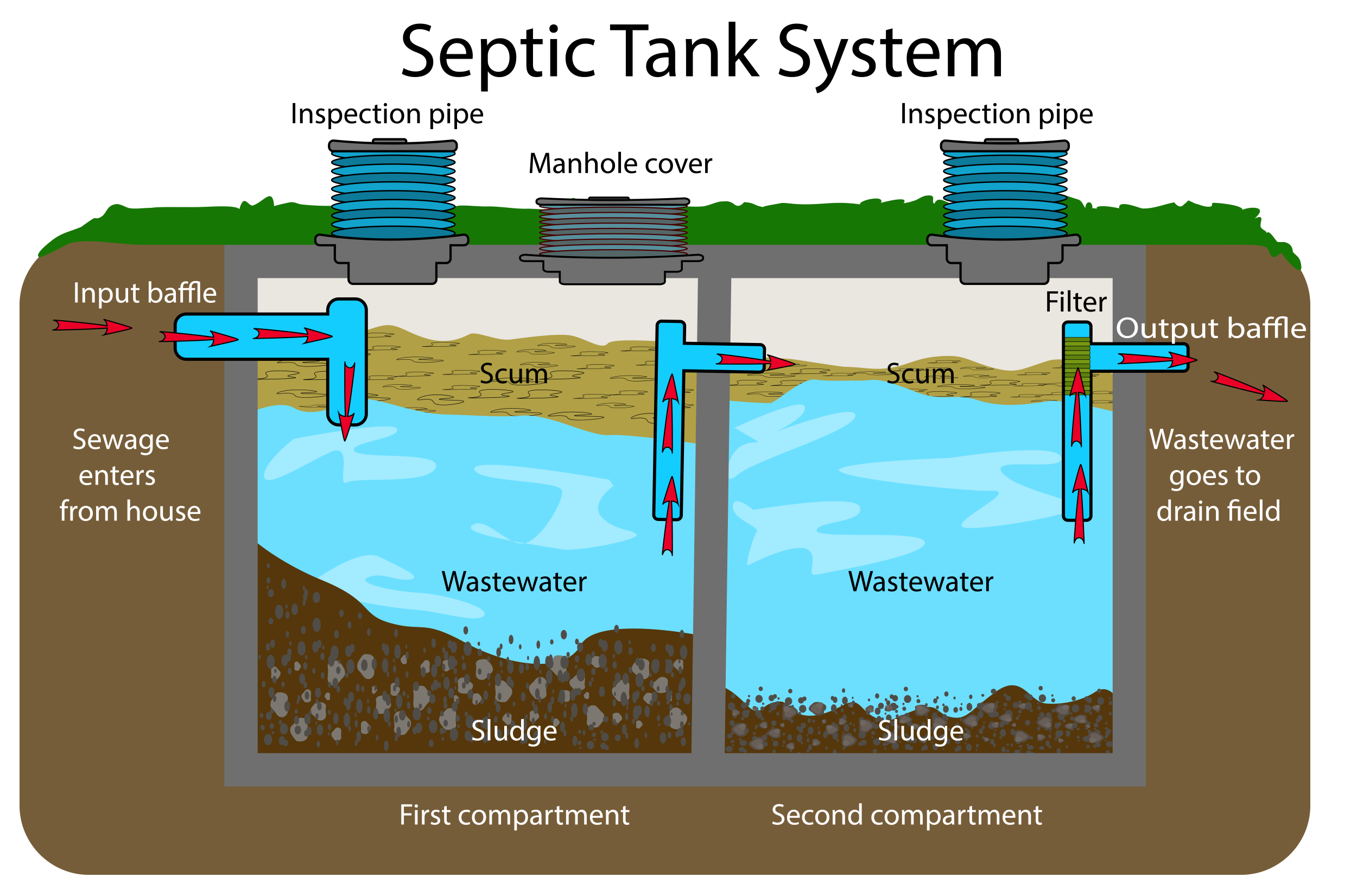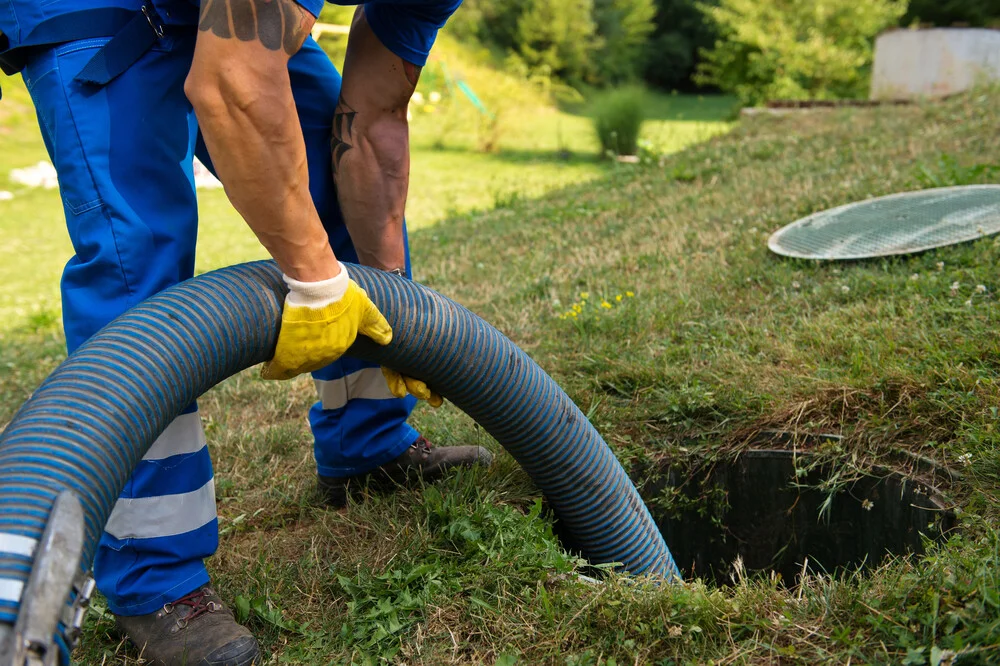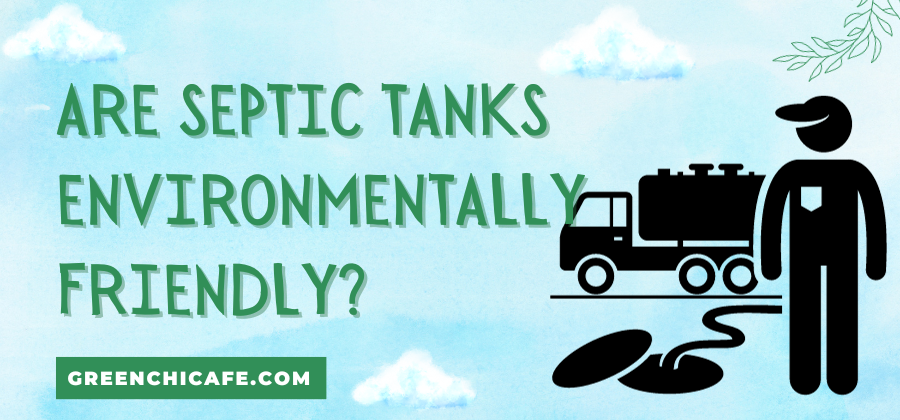Last Updated on June 3, 2024 by Annie Baldwin
Sewage treatment is an important environmental issue.
Many homes rely on septic tanks to process waste and wastewater but, are these systems really eco-friendly?
Let’s take a closer look at the environmental impact of septic tanks.
Are Septic Tanks Environmentally Friendly?

Septic tanks are generally environmentally friendly and have a positive impact when properly maintained.
They provide natural onsite sewage treatment through anaerobic digestion, filtering wastewater back into the ground to replenish groundwater supplies.
Well-designed and managed septic systems recycle water, eliminate waste, and prevent pollution of nearby surface waters.
However, failing or poorly located septic tanks can contaminate waterways and spread disease.
Regular septic tank pumping, inspections, and upkeep are crucial to maximize environmental benefits.
Innovative eco-friendly septic options like constructed wetlands offer even more sustainable wastewater treatment.
Overall, septic tanks are a green, cost-effective choice compared to centralized sewage plants.
Key Points
- Septic tanks filter and treat wastewater naturally using anaerobic bacteria, avoiding pollution.
- Proper maintenance like regular pumping is vital to prevent septic system failure and contamination.
- Eco-friendly septic tanks incorporate additional filtration through constructed wetlands or sand filters.
Our Opinion
When installed and maintained correctly, septic tanks are an excellent environmentally responsible option for household wastewater treatment.
Their natural biological processes recycle water and nutrients onsite while protecting groundwater and surface water quality.
Septic systems are a sustainable, decentralized solution that avoids the need for large centralized sewage plants and long pipe networks.
While regular upkeep is crucial, innovative eco-friendly septic designs can provide even more effective and reliable treatment through natural wetland filtration.
Overall, septic tanks are a green alternative that allows homes to safely process waste.
Are Septic Tanks Eco-Friendly?

Septic tanks can be an environmentally friendly choice compared to other waste treatment options. When properly maintained, septic systems break down waste products and prevent the spread of bacteria and communicable diseases. Here are some of the benefits:
- They eliminate waste and recycle water back into the ground. This allows for natural replenishment of groundwater supplies.
- They use natural processes like bacterial action to break down waste. This is a more eco-friendly alternative to chemical-based sewage treatment plants.
- Well-functioning septic systems discharge minimal amounts of treated wastewater. This poses little threat to nearby vegetation and wildlife.
- Innovative septic designs utilize passive treatment systems. These cultivate helpful bacteria that neutralize waste naturally.
However, failing or poorly maintained septic tanks can contaminate groundwater and release untreated wastewater containing harmful substances. Regular septic maintenance is crucial to ensure systems function properly and remain environmentally friendly.
How Do Septic Systems Work?
Septic systems provide an on-site sewage treatment solution for homes and properties not connected to main sewer lines. Here is a quick overview of how they work:
- Wastewater from sinks, toilets, washing machines, etc. flows into the septic tank. This is usually a large concrete or plastic container buried underground.
- Inside the tank, solids sink to the bottom forming sludge while oils and grease float to the top as scum. Baffles and filters ensure that only clarified effluent leaves the tank.
- The clarified wastewater flows from the septic tank to the drain field, also called a leach field or soil absorption system. This consists of perforated pipes buried in gravel and soil.
- In the drain field, natural biological processes and filtration remove contaminants, pathogens, and nutrients from the wastewater.
- The treated water is slowly released into the surrounding soil, where it eventually reaches groundwater.
- Regular pumping of the septic tank is crucial to remove sludge buildup and prevent clogs or backups in the system.
- Well-designed, properly maintained septic systems provide efficient, eco-friendly waste treatment for homes not connected to sewer lines.
Septic Tank Pros and Cons

Septic systems have advantages and disadvantages compared to centralized sewage treatment. Here are some key points to consider:
- Septic systems allow homes in remote areas to have on-site wastewater treatment. This avoids the need for costly connections to distant sewer lines.
- They are generally a cost-effective solution, with lower installation and maintenance costs compared to sewer connections. The homeowner covers the costs rather than the whole community.
- When properly sited, designed, and maintained, septic systems effectively treat household wastewater and prevent disease outbreaks.
- That said, septic systems do require regular maintenance like pumping out sludge to prevent backups. Neglect can lead to malfunctions, overflows, and groundwater contamination.
- While modern systems utilize innovative treatments like aerobic digestion to reduce pollutants, nutrient and pathogen removal is often not as thorough as municipal sewage plants.
- Poorly sited or failing septic systems can contaminate nearby wells, lakes, streams, or groundwater. Regular testing and diligent maintenance help prevent this.
- Septic systems have a finite capacity and require drain field replacement when saturated. Sewer connections don’t have this limitation.
- Overall, septic tanks are a safe, eco-friendly choice when properly maintained. But weigh the pros and cons carefully based on your specific needs and site conditions.
Alternatives to Septic Systems
While septic tanks are a popular wastewater solution, there are other options to consider:
- Sewer connections are preferable where available, as centralized sewage treatment is generally more advanced and reliable. Though hookup and service fees apply.
- Composting toilets allow waterless, eco-friendly waste treatment onsite. Though compost must be properly disposed of.
- Incinerating toilets eliminate waste through burning, but may not be legal everywhere. Energy costs apply as well.
- Greywater systems filter and reuse wastewater from sinks, showers, etc. Blackwater from toilets still requires separate treatment.
- Constructed wetlands utilize natural processes in man-made marshes to treat wastewater passively onsite.
- Packaged treatment plants are compact, modular systems providing advanced processing. Higher complexity and costs than basic septic.
- Cluster systems share an oversized drain field between multiple homes. Reduces land needs but requires coordination.
- No single solution is right for every scenario. Evaluate all options carefully based on costs, wastewater volumes, soil conditions, regulations, and environmental impacts.
- With research and planning, there are effective and eco-friendly alternatives to traditional septic systems worth exploring before installing one.
Maintaining an Environmentally Friendly Septic Tank
Keeping your septic system operating properly is key to minimizing environmental impacts:
- Inspect and pump frequently – every 2-3 years for a household. Prevent solids buildup.
- Use septic additives judiciously. Most are unnecessary, some can harm the tank.
- Avoid disposal of harsh chemicals, pharmaceuticals, oils, etc which damage bacteria.
- Direct surface water drainage away from the leach field to prevent oversaturation.
- Don’t drive vehicles over the drain field or build structures over it. Compaction damages pipes.
- Only native grass should be grown over the field. Roots aerate soil but don’t clog pipes.
- Conserve water to reduce hydraulic overload of the system. Fix any leaky plumbing.
- Allow only wastewater into the tank – no stormwater or groundwater infiltration.
- Keep accurate records of septic maintenance and service for future homeowners.
- A well-designed and properly maintained septic system lasts for decades. However neglect can lead to premature failure, costly repairs, and contamination.
- With regular care, your septic tank can provide safe, economical, long-term wastewater treatment while protecting the surrounding environment.
FAQ
What Are the Environmental Benefits of Septic Tanks?
Septic tanks can provide environmental benefits by naturally filtering and treating wastewater onsite, reducing the need for centralized sewage treatment. The anaerobic bacteria in septic tanks break down waste and pathogens. Septic systems recycle water back into the ground, replenishing groundwater supplies. They allow treated wastewater to be absorbed and filtered through the soil, protecting surface water quality. Well-maintained septic systems prevent raw sewage from contaminating waterways.
What Is an Eco-Friendly Septic Tank?
Eco-friendly septic tanks utilize natural processes like anaerobic digestion, filtration, and UV radiation to treat wastewater passively without electricity or chemicals. They may incorporate constructed wetlands, sand filters, or peat filters to remove nutrients and pathogens. Some eco-friendly options use pre-treatment with grease traps and effluent screens. Choosing plastic-free and chemical-free septic tanks with minimal concrete also makes them more environmentally sustainable.
What Is the Most Eco-Friendly Sewage System?
The most eco-friendly sewage systems recycle wastewater onsite through natural biological processes and soil percolation. This includes composting toilets that turn human waste into usable compost. Constructed wetlands filter wastewater through natural vegetation. Living machines use greenhouse-like containers to mimic tidal wetlands. Septic tanks paired with drain fields or seepage pits allow ground absorption. These passive, decentralized systems have minimal environmental impact.
What Are the Disadvantages of Septic Tank?
Some disadvantages of septic tanks include the need for regular pumping to remove sludge, costly maintenance and repairs, limited lifetime, and the potential to contaminate groundwater if not properly sited and maintained. Old or damaged septic tanks can leak nutrients, bacteria, and viruses into groundwater and nearby water bodies. Septic systems also require large drain fields and space that may not be available in some areas. Homeowners must be diligent about conserving water and properly maintaining their septic tanks.
Conclusion
Septic tanks can be an environmentally friendly waste treatment solution when properly sited, designed, and maintained. Septic systems recycle water onsite, replenish groundwater, and avoid the need for centralized sewage treatment plants. The natural biological processes in septic tanks break down waste and pathogens. High-performance eco-friendly septic designs utilize additional natural filtration through constructed wetlands, sand filters, or peat to protect water quality. While septic tanks have drawbacks like regular maintenance needs, overall they provide a decentralized, low-impact way to effectively treat household wastewater if managed responsibly.
